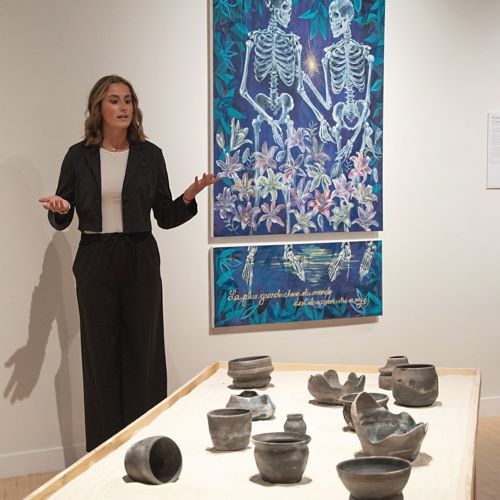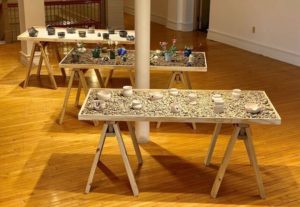
Dual research in psychology and studio art helps validate art therapy career goals

For several summers, Lucy Agurkis ’23 worked at Camp Squanto in New Hampshire—it’s where her parents met, and it’s a special place that the entire family cherishes. She recently ran the arts and crafts center and mentored campers and staff as she moved up in leadership. It wasn’t until after a sister’s experience with art therapy that Agurkis realized she could combine her camp skills and her college majors at The College of Wooster in psychology and studio art.
“I.S. helped confirm what I want to do with the rest of my life. The most exciting part of my projects was seeing how much of an impact art can have on people’s mental health. I’m drawn to art because it is so relaxing, and if I can help other people, too, that is the best of both worlds.” —Lucy Agurkis ’23, I.S. titles: Coloring Away the Blues: Exploring the Therapeutic Effects of Art Activities on Well-Being and Molding a New You: Exploring the Therapeutic and Healing Properties of Clay
“My sister experienced art therapy at a mental health facility and called saying the art therapist reminded her exactly of me,” recalled Agurkis. “I started researching the profession and realized this is exactly what I want to do with my life. Having the opportunity to do Independent Study work gave me a chance to dive into art therapy for the first time.”
Agurkis completed two separate but related I.S. projects, along with an art exhibit and an art portfolio. Working with mentor Meredith Hope, assistant professor of psychology, she recruited 50 undergraduate students to complete three surveys about stress and anxiety before and after completing a 20-minute art activity. Participants colored in a pre-designed mandala or worked with clay. As she hypothesized, students showed much more stress and anxiety in pre-art surveys than post-art surveys. While both activities helped, she could see the trend in clay providing a larger decrease even though it wasn’t statistically significant enough for a full result.
On the studio art side with mentor Daren Kendall, assistant professor of art and art history, Agurkis wanted to build off the psychology study but put herself into the work this time. “I’ve always been drawn to clay and ceramics, and the studio art study let me dive into the healing properties of clay,” she said. “I spent the year almost trying to run an art therapy program for myself.”
Every week, Agurkis’ advisor gave her a different prompt for creating with clay which gave her the ability to be really present and conscious in the moment instead of restricted to making something specific. “I didn’t plan what I was making, I just started and saw what came out of it,” said Agurkis. “I put myself into the work and used it as an opportunity to dive into my own mind and see how I was doing.”

Agurkis’s art displayed in Ebert Art Center. Photo credit to Lucy Agurkis
She created 50 pieces of work and designed an exhibit that also included the student clay pieces from her psychology study. Those items included an elephant, pumpkin, pizza, a cactus, and a snail, among other interesting creations.
Seniors working on I.S. and studio art majors get a personal work space, so all of her research occurred either in her personal research room in Morgan Hall or in her art studio in Ebert Art Center. While the majority of psychology I.S. projects rely on online survey data collection, Agurkis’ project required her to collect in-person data and supervise participant art-making. It was a significant time commitment for a student taking classes and completing an additional I.S. project in a different department. The studio art department funded the clay used in both of her studies.
Though she was nervous about completing two separate projects, Agurkis said she felt prepared and supported going into senior year. “My advisors have been wonderful. They keep me on track but also check in on my mental health,” said Agurkis. “I was fully prepared and felt very cared about and very seen at Wooster.”
She hopes to work on bigger studies in the mental health realm to gain experience before looking at graduate schools. Ultimately Agurkis dreams to work in art therapy, either in an eating disorder facility or a hospital, and loves to work with children and young adults.
“I.S. helped confirm what I want to do with the rest of my life,” said Agurkis. “The most exciting part of my projects was seeing how much of an impact art can have on people’s mental health. I’m drawn to art because it is so relaxing, and if I can help other people, too, that is the best of both worlds.”
Photo 1: Lucy Agurkis ’23 presenting her art. Photo credit to Jodi Robison.
Posted in Independent Study on May 17, 2023.
Related Posts
Related Areas of Study
Art - Studio Art
Studio space, small classes with talented instructors, and the strong foundation that comes with a liberal arts education.
Major MinorPsychology
Do research, work with faculty mentors, and tailor a psychology program to your interests
Major Minor

